| |
|

REFLECTIONS
The emperor is even worse than naked
By Sheila Orysiek
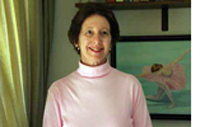 SAN DIEGO—I rue the day a painter decided the paint accidentally spilled on a canvas was art, a composer concluded music with a melody was passé, a sculptor eschewed recognizable form, a poet decided it was easier not to rhyme, a dancer discovered that she could put a foot by her ear and when another dancer decided he had to jump higher than everyone else. But I rue the day even more when this was not only presented as art, but accepted as art. SAN DIEGO—I rue the day a painter decided the paint accidentally spilled on a canvas was art, a composer concluded music with a melody was passé, a sculptor eschewed recognizable form, a poet decided it was easier not to rhyme, a dancer discovered that she could put a foot by her ear and when another dancer decided he had to jump higher than everyone else. But I rue the day even more when this was not only presented as art, but accepted as art.
Though I find this trend disturbing across the various art genres, I will use dance as an example. Mikhail Fokine was one of the great choreographers of the 20th century - many of his creations are still treasured in the repertoire of major dance companies around the world. Ballets such as Les Sylphides, Petrouchka, Scheherazade, Dying Swan, Spectre de la Rose, Firebird - 60 in all.
In a discussion of trends in art Les Sylphides is of particular interest. It was choreographed in 1908 for the renowned Mariinsky (Kirov) Ballet of St. Petersburg, Russia, using Chopin's glorious music. Fokine had specific reasons for creating this ballet and it remains a seminal work in several ways. He wanted to illustrate that innovation could come about without distortion or sacrificing intrinsic values. Innovations such as:
The first plotless ballet - no story.
Strict costuming - no alterations by a privileged ballerina.
Strict hair design - no alterations.
First time a dancer turned his/her back to the audience.
First time a dancer moved on stage - however briefly - without music.
Choreography was exact - a privileged ballerina or danseur couldn't throw in her/his favorite steps.
The dancers were at the service of the art form not vice versa.
As important as these principles are Fokine's most important intent was to bring ballet as a whole back from what he saw as a downward slide into athleticism - tricks of the trade - and away from artistry. Les Sylphides is difficult to dance - not only because of the pure classical technique but for the artistry - the delicate nuance - the unspoken message - the gesture - poetry - style - the seeming ease disguising all difficulty - and, yes, the sheer symmetry of line and shape. Fokine wanted to bring ballet back to its raison d'etre. The problem is - Fokine died.
George Balanchine, another of the great choreographers of the twentieth century, fused the music and the dance - as he said: “Hear the dance, see the music.” His intent was to show the beauty of the human body moving to inspiring - meaningful - music. While his choreography courted virtuosity, it was never clever technique or athleticism for its own sake. The problem is - Balanchine died.
I don't want to hear music which is a collection of various disparate sounds that accidentally came together. Labeling it music doesn't make it music. Music used to have a structure. It provoked a responsive emotion - happiness, sadness, reflection, beauty, - the problem is Mozart, Beethoven, Tchaikovsky, et al - died.
One day a ballerina discovered she could put her pointe shoe next to her ear, and even more beguiling - she could do it with her foot still inside her pointe shoe. That's what is happening more and more. How high can the leg go. How many times can the dancer turn. How high can the dancer jump. How many times can the leg touch the back of the head. How many ways can the dancer stretch. I purposely haven't put in the correct punctuation question marks - because I don't care about the answers. I'm tired of it all.
Recently at the Orange County Performing Arts Center I attended an evening of dance featuring world renowned principal dancers from one of the oldest, most prestigious ballet companies (The Mariinsky-Kirov Ballet of St. Petersburg, Russia), products of one of the finest schools - the knowledge, tradition and reputation is over 300 years old. So this lament is not about the ability of the dancers - they were stellar throughout - but about what they did - what the dance world in general seems to be doing with all that talent.
In two hours of dance - not one moment of beauty - not one moment of identifiable meaning; lots of talent, work, dedication - but no beauty, no context. And, as far as I'm concerned jump, jump, turn, turn, leg by the ear has no artistry - no message - no lasting image. At one point I closed my eyes for about ten minutes (wishing I could close my ears too) and when I opened my eyes found I had missed nothing; they were still doing more jump, jump, turn, turn, leg by the ear, ad infinitum. Thus, this is not a review as such, but a sad and angry protest. And I haven’t supplied the dancers’ names - it’s not about a single event but a trend.
Let’s examine a specific ballet pas (step/movement) the grand jeté - the fully split jump soaring across the stage - usually so exciting a part of the dancer's repertoire. If the split is past 180 degrees - the legs are over-split - well, it's no longer exciting as a dance pas - it has become - forgive me - a crotch shot. Ditto for splayed legs in any other direction.
Where's the beauty of a leg extended to the side of the dancer's ear? What does it mean when she touches the back of her head with her foot? Once? Twenty times? Who cares? No one doubts her/his flexibility - I want to see artistry. What I am seeing is gymnastics in pointe shoes. This is not to denigrate gymnastics - which I enjoy for what it is. I don't like gymnasts who pretend they are ballet dancers, either. I don't want to go to a performance and see empty movement to raucous empty sound.
It is not that I want ballet to remain frozen in time - the technical possibilities have advanced enormously - but that doesn’t give license to indiscriminate usage. When every arabesque is above 90 degrees, all the nuance of the other degrees is lost. The original hesitancy of Juliet’s low arabesque when first meeting Romeo is now gone since it is always presented as well above 90 degrees and therefore we lose the implication of her growing confidence. If it starts out at full throttle - where does it have room to grow? There are ballets in which the intent is technical virtuosity such as the Don Quixote or Le Corsaire Grand Pas de Deux, but even there it has to be done with taste and an eye for shape and line.
Again regarding Romeo and Juliet - it used to be the ballerina managed to die a romantic death, now she dies with “realism;” legs astraddle spanning a wide catafalque. If I want realism - I’ll go visit a morgue - not a ballet.
I feel the same way about paintings that look like accidents. Or music that relies on volume. Or sculpture that looks like something a kindergartner would be wise enough to not want to show off. I don't want to look at something and wonder if it is an accident or an intentional creation which happened recently when a major construction site was cleared away with a single pile remaining in the middle of a plaza. Took me a while to realize it was a “sculpture” and not left over debris.
This is all subjective I know - but isn't that true of all art? We see it - or not - through our personal prism. And what I'm seeing more and more is not that the Emperor has no clothes - he does - but I abhor his wardrobe.
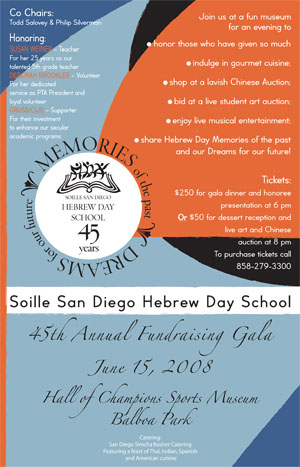 A Poem Ugly as a Tree A Poem Ugly as a Tree
Paint splattered on a canvas
Isn’t therefore a picture
Unstructured sound
Is a mish-mashed mixture
Sculpture without form
Meaning or style
Isn’t art to this observer
It’s debris in a pile
There are poets who rhyme
And some who can’t
Some have context
And some just rant
Violets are red
Roses are blue
The old may be trite
But this way is untrue
Try this for example:
I shall never see
Listen, are you ready?
A poem ugly as a tree
But obfuscation doesn’t imbue
Sophistication, as such
It’s a gilded sow’s purse
Used by a “poet” who must
A poem inhabits space
But also takes up time
It has to be smooth
Flowing into rhyme
A name like any other
Could be a rose
Words strung together
Isn’t a poem - its prose
Declaring it art
Doesn’t make it so
I question the definition
But, then, what do I know?
Play tackles nature of American Judaism
By Cynthia Citron
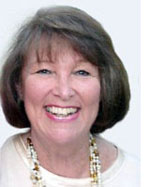 LOS ANGELES—The question of what it means to be a Jew in America is a constant subject for drama. Just in the current season it was tackled here by playwright James Sherman in From Door to Door, Russ Alben and John Sparks in The Smartest Man in the World, and last year by Ron Hutchinson in Moonlight and Magnolias. To name a few. LOS ANGELES—The question of what it means to be a Jew in America is a constant subject for drama. Just in the current season it was tackled here by playwright James Sherman in From Door to Door, Russ Alben and John Sparks in The Smartest Man in the World, and last year by Ron Hutchinson in Moonlight and Magnolias. To name a few.
Now Daniel Goldfarb’s award-winning play, Adam Baum and the Jew Movie, first produced in New York in 2000, has opened in Los Angeles at the Hayworth Theater in a sparkling production directed by Paul Mazursky, and it tackles the subject anew.
Comedian/actor Richard Kind stars as Hollywood studio head Sam Baum, a thinly disguised replica of Samuel Goldwyn, malaprops and all. It is 1946 and Sam has hired writer Garfield Hampson, Jr. (Hamish Linklater) to make a screenplay out of a book called Soil in Utopia, which has a Jewish theme and tackles the problem of anti-Semitism. But Sam is in a hurry: Moss Hart is finishing up a script called Gentleman’s Agreement for Darryl Zanuck which covers the same territory, and, according to Sam, “America can only handle one Jew movie a year!”
Moreover, Sam wants to star Cary Grant in his movie. When Hampson protests that Grant isn’t Jewish, Sam counters with “You can’t have a Jew play a Jew! The only Jews we put in parts, they play Indians!” Sam reminds Hampson that he (Hampson) isn’t Jewish, either, but he’s “the best Goyisher writer in Hollywood,” to which Hampson responds, “I’m the only Goyisher writer in Hollywood!”
Hampson has steeped himself in Jewish culture, researching meticulously for months. But he doesn’t really “get” it and is missing all the nuances. He doesn’t understand Sam’s need to see himself and other Jews as “real Americans.” Hampson wants to make a heavy-duty drama, while Sam’s goal for his movies is to provide “a nice escape from life.” He wants Hampson’s script to be “more like Wuthering Heights.”
Meanwhile, Sam is heavily involved in the preparations for his beloved son’s Bar Mitzvah. (In fact, the warm, playful interactions between Sam and his son Adam are some of the best scenes in the show.) Adam is played by a marvelous young actor named Gregory Mikurak, who currently also plays Harry in The Boychick Affair: The Bar Mitzvah of Harry Boychick every Sunday afternoon at the Hayworth’s upstairs theater.
On the spur of the moment, Sam invites Hampson to Adam’s Bar Mitzvah, anticipating that it will be a learning experience, an opportunity for Hampson to see Jews having a good time at a fancy party. But the plan backfires, as Hampson sums up his views of the event: “I learned about excess,” he declares. “Fur coats in June and capitalism at its worst.” He adds, “You created the American Dream, and it excludes you!” Finally, he launches an attack on Sam’s brand of secular Judaism, challenging him on his non-observance of the religious practices and traditions of his faith.
Sam is angry, indignant, and non-plussed and, in a final moving moment, comes to understand the role of Judaism in his life. He also recognizes that “what makes me a Jew is the Gentile.”
Adam Baum and the Jew Movie is a searing, funny, engaging play, beautifully mounted, well-directed, and exquisitely acted by all three men. Production Designer Joel Daavid has provided two elegant and sumptuous sets: Sam’s expansive office in Act One, and his extravagantly furnished den in Act Two. Traci Me Wain provides appropriate costumes, and Richard Kind looks terrific in the tux that he wears to the Bar Mitzvah. Christopher Game’s sound design is also well done, with a dramatic finale that sums up the whole play in an instant.
Adam Baum and the Jew Movie will continue Thursdays, Fridays, and Saturdays at 8 p.m. and Sundays at 7 at the Hayworth Theatre, 2509 Wilshire Blvd., in Los Angeles, through July 20. Call (323) 960-4442 for reservations.
THE JEWISH CITIZEN
Frieda's big surprise at Frida's Restaurant
By Donald H. Harrison
 CHULA VISTA, California—Retired urologist Israel Barken had the operation planned as precisely as a pioneering surgical procedure. To make certain that Operation Frieda-Frida-Frida would be the surprise of a lifetime for his wife, Frieda, it came a day after her 60th birthday. CHULA VISTA, California—Retired urologist Israel Barken had the operation planned as precisely as a pioneering surgical procedure. To make certain that Operation Frieda-Frida-Frida would be the surprise of a lifetime for his wife, Frieda, it came a day after her 60th birthday.
A diversionary dinner was staged on Friday, June 6, on Frieda’s actual birthday at their home near San Diego’s Mission Trails Regional Park. It was attended by immediate family members including daughter Randi, son-in-law Scott Sonenshein and 11-month-old granddaughter Myaan who had flown in from Houston, Texas. Not only that, the home dinner was served to Frieda—the first time in anyone’s memory that when the entire Barken family had eaten together, Frieda hadn’t prepared the meal.
Frieda, who tends not to like people fussing over her, was totally taken in, expressing her satisfaction that her 60th birthday had been celebrated at home in a wonderfully memorable and haimish way.
Besides Randi and family, the gathering included the Californians: Frieda’s mother Sophie Rochman; her son Lee and daughter-in-law Stephanie; son Martin; and son Derren and daughter-in-law Keren.
At one point, the conversation went something like this: “Oh, but wait, mom, there is another fun event we have planned,” her daughter and daughters-in-law said. “Can you believe it? Tomorrow, we’re all going to go to the spa at Loew’s Coronado Resort for a manicure and a pedicure. And we’ve got a room there for you and dad to stay the night.”
As for dinner, they said, they’d meet the fellows at a restaurant near Lee’s and Stephanie’s Otay Ranch home, and then maybe after dinner, have dessert and coffee at their house. Sounds great, agreed Frieda, fully assuming the birthday festivities were now safely in the past.
So, on Saturday evening, June 7, she and Israel drove to the Otay Ranch Town Center. “What’s the name of the restaurant?” Frieda asked her husband as he headed down Olympic Parkway. “Oh, I forget,” he said. “But I’ve got very good directions and I’m sure I’ll remember when we get there.”
The restaurant’s name was Frida—and as some 50 friends and relatives of Frieda’s knew from constant emails and phone call reminders from Israel—it has two entrances, one on the west, which he and Frieda would enter, and the patio entrance on the east, where we all should wait in ambush. Please, please, park on the east side of the restaurant and come early, Israel implored. So most of us did, and those who didn’t, came late enough to not spoil the surprise.
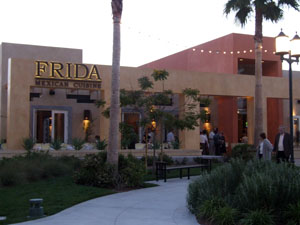 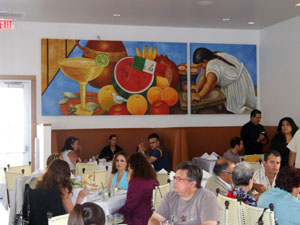
While traversing the elegant, four-month-old, white-table-cloth- and- china Mexican restaurant with its huge art works and an interior patio built around an old olive tree, Frieda was told that with the weather being so nice, Lee and Stephanie had made arrangements to eat outside on the patio. Anyone who saw the absolute look of astonishment on Frieda face when the crowd, including some out-of-towners whom she hadn’t seen in years, yelled surprise and then sang “Happy Birthday” to an accordionist’s accompaniment would know that the Family Barken’s mission had come off flawlessly.
Frida, the restaurant, was named for Frida Kahlo, the artist who was the daughter of a Hungarian Jewish father and Mexican Catholic mother, and whose tempestuous love affair with muralist Diego Rivera was as well known—perhaps even better known—than her autobiographical paintings. This is one of several restaurants opened by owner Vicente del Rio. The original, in Beverly Hills, is said to be a favorite of actress Salma Hayek, who played the title role in the 2002 movie, Frida. Others are located in Santa Monica and Glendale, and there are plans to open another in Las Vegas.
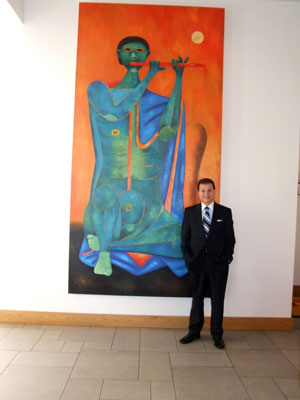 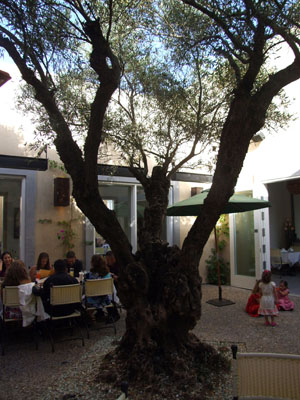
According to the restaurant’s general manager Luis Brik, Kahlo was the inspiration for the olive tree in the interior court yard. In her dying days, when she was bedridden, Kahlo found solace and beauty in the olive tree that she could see out her window, he said.
Although I did not spot any Kahlo-style paintings, which typically included her face, several paintings after the style of Diego Rivera graced the restaurant, and there was one extremely large painting that Brik said copied the work of another of Kahlo’s contemporaries, muralist David Alfaro Siqueiros.
Although the large patio group proved a logistical challenge to the polite and helpful service staff, and the space heaters were overwhelmed by the cool California evening, the “urban Mexican” dinner was both interesting and tasty. The bar featured margaritas, including one we were solemnly told had been a favorite of Frida Kahlo: a blackberry margarita. The appetizers included chicken taquitos, corn masa rounds topped with beans, lettuce, sour cream and queso fresco and guacamole. They were followed by tortilla soup, garnished with avocado, cheese, cream and guajillo chile. A word to the wary, the tray of garnishes also has on it pork rinds, which kosher-style diners might eat by mistake.
There were four choices for the main course: enchiladas tapatias (which could be filled with either chicken or cheese), mole poblano (chicken in a chile chocolate sauce), arrachera nortena (a charbroiled skirt steak accompanied by an enchilada, cactus salad, guacamole and rice) and salmon aqua (a grilled salmon in white wine sauce).
Having been told by Brik that “one thing we know that Frida liked a lot was the mole,” I tried it, especially after he told me that “we are making it the old fashioned way with shredded chocolate, so it is a very authentic recipe.” Mole is an acquired taste; some of the Israeli guests (from Israel Barken'’s native country) with whom I shared a table could not believe anyone would put chocolate—even mixed with chile—on their chicken. Well, I’ve always had difficulty understanding how Israelis spread a chocolate mixture on bread the way Americans do peanut butter!
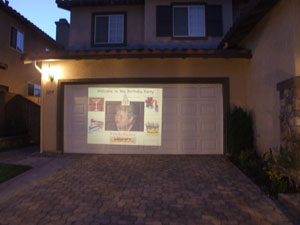 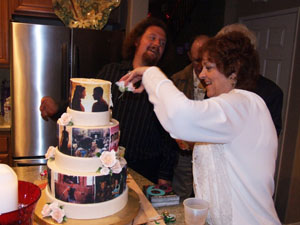
By design, there were no dessert choices on the menu. Instead, the group cavalcaded to Lee and Stephanie’s home, where a multi-tiered cake garnished with edible scenes from some of Frieda’s favorite movies was waiting. A computerized poster of Frieda perhaps big enough to impress muralists Rivera and Siqueiros was affixed to the garage, and inside the home, there were automated slide projections in two rooms showing the life and times of Frieda Barken. For good measure, the images also were projected from the back yard onto an exterior wall of the house.
Frieda-Frida-Frida-Freida.


 


SDJA STUDENT QUARTERLY
Editor's Note: The following three stories are reprinted from the current issue (June 2008) of SDJA Student Quarterly, the student publication of San Diego Jewih Academy. San Diego Jewish World editor Donald H. Harrison serves as a journalism teacher and newspaper advisor at San Diego Jewish Academy.
Across the editor's desk
By Alexa Katz
This year is almost over and it has further confirmed why I continue to love this school. From our ASBC vote off between Gabriel Magun and Shiri Bogomolny to our surprise carnival day and Purim powder puff, this year has been chocked full of fantastic activities which have concluded with the extremely successful junior lock down and Laser Tag. It may be a cliche to say so, but this year has gone by extremely fast. It seems like just last week we were clamoring to switch electives and banging on bongo drums.
In this issue I am proud to say we included many writers from outside the newspaper staff and they have written excellent stories about a variety of topics including college, anti-Semitism and ASBC. By having writers from tside our small staff we hope to expand the opinions and thoughts that this paper represents. By doing this we hope that we have perfected our goal of accurately representing the student body.
The newspaper would not be possible without four teachers who have donated both their time and patience to the newspaper staff: Dusty Wood, Doug Kipperman, Melissa McKinstry and Don Harrison.
Wood and Kipperman pushed their photography and art classes to create the best art possible for this paper, and all of the art published in the middle section has been particularly excellent. Kipperman also should be commended for working long hours both after school and on weekends on InDesign being directed by both Don Harrison and me. Without Kipperman's expert knowledge and willingness to help I doubt the newspaper would have been as successful as it was. I would also like to thank him for lending me his wisdom throughout this process. McKinstry was also extremely supportive in the creation of the SDJA Student Quarterly, and I would like to thank her for letting the newspaper use her room and expertise.
Lastly, I know the newspaper would not have been possible without the expert advice of Harrison. Throughout the year he constantly encouraged and perfected our journalistic skills. We learned how to question correctly, write leads, format articles and many other skills throughout this year because of him. He truly molded a group of students into a group of journalists. He also donated much of his time to editing and re-editing articles as well as staying after school and coming in weekends to make sure the newspaper layout was as close to perfect as possible. I truly could not think of a better newspaper advisor.
I would also like to thank the entire newspaper staff. These students are all top-notch writers who brought their own unique flavor to the paper. Furthermore, although they were extremely busy with school and a variety of extracurricular activities, they still found time to go above and beyond in that they wrote about topics that were important for the paper. Their dedication to journalism is truly admirable.
Finally, the administration really helped to foster journalism by letting the staff cover stories that sometimes were critical of SDJA policies. Not every school administration would have been enlightened enough to permit this type of reporting. The newspaper staff is greatly appreciative of this.
SDJA 'Spring Fling' went under water
By Michelle Rizzi
The ASBC (Associated Student Body Council) decided to do things a little differently this year. Instead of hosting a Winter Formal dance, as in previous years, it hosted the first-ever Spring Fling dance March 29.
The ASBC planned months in advance to make the dance different than all others. The theme of the dance was Under-the Sea, and ASBC members worked hard to give the Music room, where the event was held, an underwater vibe. I helped Rose Sheela make paper waves that lined the walls and were decorated with paper fish that Dani Lurie cut out. The DJ brought lights that contributed to the effect. Prior to guests arriving, Eli Recht, ASBC member and senior, stated: "I feel like I'm swimming!"
Several high schoolers brought guests from outside of school; at one point, they outnumbered the students. "There were at least 100 people in the room at some point of the night," commented Michele Goldfarb-Shapiro. Although most of the upperclassmen arrived fashionably late, and dressed to impress, the underclassmen arrived on time and ready to boogie.
ASBC members expressed the hope that the Spring Fling dance will be an annual event that will continue in SDJA history.
Fellowship to Jack deTar
By Gaby Maio
Every year, the Bronfman Youth Fellowships in Israel selects twenty-six students to participate in a five-week program in Israel where the students will be among writers, philosophers, moral leaders and government leaders. They spend a week in the Negev and stay with an Israeli family for a few days. The program is tailored towards young Jewish leaders, where famous writers such as Jonathan Safran Foer and Lemony Snicket have participated. Jack deTar, an eleventh grade student here at SDJA, has been selected among hundreds to participate in such a program.
Jack deTar was approached by Steve Kahn, Dean of Academic Affairs at SDJA, who urged Jack to apply despite the low chances of getting in. Jack eagerly took up his offer and began filling in the application, which he likes to describe as a "miniature college application." He wrote about himself, his interests, hobbies, and important morals and values that he holds close t him.
Despite putting in hard effort, his expectations of getting in were not high. When he received the phone call that he had made it to the top sixty-four, he was both nervous and surprised.
Going on to the next step, Jack was interviewed by the director of the program, Rabbi Shimon Felix. He was asked to express his take on the Israeli-Palestinian conflict, his view on Judaism, and what he wanted to do with his life.
A short while after, Jack deTar received another phone call congratulating him on making the final cut to join the Bronfman Youth fellowships Program in Israel. Jack ran into Dean Kahn's office screaming and called numerous friends because he was excited and admitted he was a little stunned. While Jack claims that he "just got lucky," we can all say that he not only deserves this opportunity of a lifetime but that he is fully talented, incredibly gifted, and on to becoming a leader in this world.


ADVENTURES IN SAN DIEGO JEWISH HISTORY
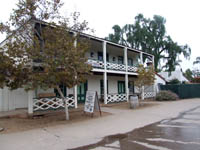
Robinson-Rose House
|
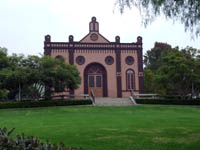
Old Temple Beth Israel |
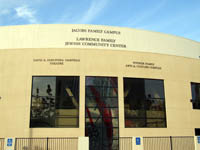
Lawrence Family JCC |
Editor's Note: We are reprinting news articles that appeared in back issues of various San Diego Jewish newspapers. You may access an index of the headlines of those articles by clicking here. You may also use the Google search program on our home page or on the headline index page to search for keywords or names.
J.C.R.A.
From Southwestern Jewish Press, March 6, 1947, page 6
The following is a letter which was written by the wife of a family man who was recently sent to the sanatorium at Duarte by the local Jewish Consumptive Relief Association. After reading it one will then get an inkling of the tremendous good this organization is doing.
Such work deserves the backing of every red blooded person in this community. The sanatorium is non-profit, non-sectarian.
Anyone who wishes to help this worthy cause can do so by attending the Purim Supper on Thursday, March 13th, at 6 p.m. at the Beth Jacob Center. The best culinary artists in the auxiliary will prepare such a delicious dinner that even "Hamen" will drool at the mouth.
"Dear Mrs. Shelley and members of the J.C.R.A.
May I take this opportunity to express my utmost thanks for all your efforts in getting my husband into the "City of Hope" sanatorium.
A few days ago I visited him and found him to be happy and contented. The Doctors, nurses and all the attendants are all most helpful and kind to him. The food is excellent. In other words, I want to say that there could not be a better place for him. To proply express my thanks, words fail me. I do know that we owe all this especially to you and your untiring efforts in this work. My husband joins me and my family in thanking you again and send his best regards."
Signature withheld at writer's request.
Beth Jacob Sunday School Holds Purim Party
From Southwestern Jewish Press, March 6, 1947, pages 7, 8
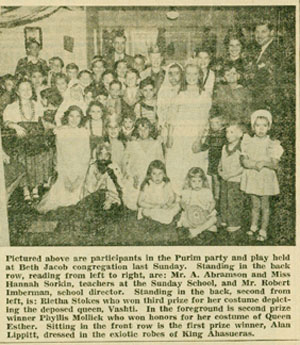 "This is Station C—B—J 1947, on your dial, calling Shushan on overseas hookup. Shushan, come in." this was the novel introduction for the Purim program given by the Sunday School of the Congregation Beth Jacob. "This is Station C—B—J 1947, on your dial, calling Shushan on overseas hookup. Shushan, come in." this was the novel introduction for the Purim program given by the Sunday School of the Congregation Beth Jacob.
Children entered the hall and squealed with delight when they saw the sign which said, "Open the Megillah, Richard." A modern presentation of the Purim story in the form of a newscast over a make-believe microphone took the place of the traditional play. The wandering reporter, standing under a sign labeled Shushan Boulevard, asked the gaily costumed passersby about the Haman and Mordecai decrees. Children, portraying important characters in the Purim Story, were asked to give short speeches about the liberation of the Jews from Haman on the overseas microphone.
After the broadcast, prizes were awarded to the children with the loveliest and most original costumes. First prize went to Alan Lippitt who was dressed as King Ahasueras; second prize was awarded Phyllis Mollich, the lovely Queen Esther; and Reitha Stokes, dressed as the deposed Queen Vashti, received third prize.
The decorations for the party were the result of serval weeks of work by the children. Posters showing King Ahasueras, Queen Esther, Haman and Vashti were displayed around the room. Most delightful surprise of the afternoon was a realistic dummy of Haman, fashioned by Marilyn and Maxine Geron, which the children hung in effigy.
Parents and teachers enjoyed the unusual program and contributed to its success. Among those helping were Mr. Robert Imberman, director of the Sunday School, Mr. A. Abramson and Miss Hannah Sporking, teachers, the ladies auxiliary who supplied the hamantashen and other delightful refreshments, and the Beth Jacob Parent-Teacher Association.
Eli Levenson New President of San Diego Fund
From Southwestern Jewish Press, March 13, 1947, page 1
Eli Levenson, prominent San Diego attorney and World War II veteran, was elected president of the San Diego United Jewish Fund at the last regular meeting of the Board of Directors. Since his return from the service Mr. Levenson has actively participated in a number of community activities. He is the retiring president of the Lasker Lodge B'nai B'rith and the chairman of the recently organized Community Relations Advisory Committee of San Diego.
Also elected to the office at the meeting was Murray D. Goodrich, first vice president; Victor Schulman, second vice president, and Morrie Douglas, third vice president. Harry Bennett and Irving E. Friedman were reelected treasurer and secretary respectively. Members of the Executive Committee elected at the last meeting were Nathan F. Baranov, retiring president and elected as honorary life president; Louis Steinman, Jack Gross, Max Rabinowitz, Irvin Kahn, Henry Weinberger and Nathan Schiller.
The United Jewish Fund will embark on March 26 on its unprecedented campaign for $350,000 for 35 local, national and overseas agencies, first amongst which is the United Jewish Appeal. Dr. Joseph J. Schwartz, European director for the Joint Distribution Committee who has just returned from Europe, will open the campaign.
{Return to top}

Nancy Harrison
cruise & tour specialist
(619) 265-0808

SAN DIEGO JEWISH WORLD THE WEEK IN REVIEW
Middle East
Hamas acknowledges its responsibility for rocket attacks that killed 26 Israelis by Ira Sharkansky in Jerusalem
To the Israeli government: Do something! by Yankele Cohen in Kibbutz Nahal Oz, Israel
Judaism
Continual study: too much of a good thing? by Rabbi Leonard Rosenthal in San Diego
Trusting in Hashem at Bear Stearns by Robert Savit via Rabbi Baruch Lederman in San Diego
San Diego County
Green collective for Jewish institutions? by Marissa Palin in San Diego
Three articles from SDJA Student Quarterly, a student publication of San Diego Jewish Academy:
—Seniors leave big shoes for juniors to fill by Gaby Maio
—Pickets target SDJA by Eitan Frysh
—New programs in SDJA ASBC by Shiri Bogomolny
Arts & Leisure
The Schwartzes within The Brady Bunch by Cynthia Citron in Hollywood, California
Sports theme at San Diego County Fair by Donald H. Harrison in Del Mar, California
Adventures in San Diego Jewish History
—March 6, 1947: Western States Meet; Here This Weekend
—March 6, 1947: Beth Jacob to Have New Rabbi
—March 27, 1947: Wins Akiba Award
Middle East
Weighing Obama and McCain from an Israeli perspective, each has drawbacks by Ira Sharkansky in Jerusalem
UK academic boycott of Israel resurfaces by Lloyd Levy in London
Canada
New Yorker brings California-style Jewish healing service to Anglophone Toronto by Rabbi Dow Marmur in Toronto
San Diego
Three commentaries from SDJA Student Quarterly, a student publication of San Diego Jewish Academy:
—Taking the SAT: The best four hours I ever spent trying to gouge out my eyes with a pen by Micah Frank
—CA court advances march to equality by Harry Doshay
—Iran's deadly bias against gays by Sarah Abelsohn
The Arts
Chapter Eleven of Reluctant Martyr, a serialized novel by Sheila Orysiek of San Diego
When octogenarian father and 40ish son both are single, who gives dating advice? Book review by Donald H. Harrison in San Diego
Programme Request? Take A Number by Carol Davis in San Diego
Adventures in San Diego Jewish History
—March 27, 1947: U.J.F. Off To Flying Start: San Diego Aware of Unprecedented Need in 1947—Geared to Meet It
—March 27, 1947: Editorial Page: Hope, Faith and Charity
—March 27, 1947: We were there by Albert Hutler
Middle East
The presumptive presidential candidates address the American Israel Public Affairs Committee on Israel and the Middle East:
—Barack Obama to AIPAC, June 4
—John McCain to AIPAC, June 2
—Clinton: Obama a good friend to Israel
Was that Condy Rice... or Sandy Berger? by Shoshana Bryen in Washington, D.C.
San Diego
Guardians' golf and tennis tournament a fitting Seacrest fitness-center fundraiser by Donald H. Harrison in Rancho Santa Fe, California
The Arts
Thursdays With The Songs of Hal Wingard
—Purely White
—Purely Black
—Together
Insiders File
—The people behind San Diego Jewish World
Adventures in San Diego Jewish History
—Palestine Capable of Absorbing 1,100,000 Says Nathan
—Palestinian To Speak Here on Tuesday
—We Were There by Albert Hutler
)
Middle East
Condoleezza Rice's stand over Gaza scholarships is counterproductive by Shoshana Bryen in Washington, D.C.
United States of America
Elections, conversions, award ceremonies: the shehecheyanu moments of springtime by Donald H. Harrison in San Diego
Lifestyles
Women are the subject of our local Jewish trivia quiz by Evelyn Kooperman
Adventures in San Diego Jewish History
—January 9, 1947: Kaufmans Feted On Departure
—January 9, 1947: Jewish Labor Committee by Ben Feinberg
—January 9, 1947: Pioneer Women's Organization
Middle East
Israel, at 60, has many kvelling points by Dorothea Shefer-Vanson in Mevasseret Zion, Israel
Syria's 10-meter problem at the Kinneret by J. Zel Lurie in Delray Beach, Florida
The Arts
Masterful retelling of Shoah in Vilna by Donald H. Harrison in San Diego
From Red Diaper Baby to Citizen Josh by Carol Davis in San Diego
Lifestyles
Are you lazy? You can put the blame on your genes—when you get around to it by Natasha Josefowitz in La Jolla
Adventures in San Diego Jewish History
—December 16, 1946: That's What I Think by Ray Solomon
—December 16, 1946: J.C.S.C. by Joe Wertheim
—January 9, 1947: Robt. R. Nathan-Wollheim To Speak Here Monday
Middle East
Ehud Olmert, does clock tick for thee? by Ira Sharkansky in Jerusalem
Jerusalem Day at Mercaz Harav Yeshiva by Judy Lash Balint in Jerusalem
Operation Homefront: Helping our American troops, no matter our politics by Rabbi Leonard Rosenthal in San Diego
The Arts
Zohan restyles Jewish comedy by Rabbi Simcha Weinstein in New York
A production you'll get a big bang out of by Carol Davis in Solana Beach, California
Lifestyles
Why the Bella Family Circle stopped its annual tradition of selling white elephants by Sheila Orysiek in San Diego
Adventures in San Diego Jewish History
—December 12, 1946: Bergen Belsen Director to Speak
—December 12, 1946: Black Book Now at Public Library
—December 12, 1946: Welcome Home...A Job Well Done
Link to previous editions
< BACK TO TOP
|
|
